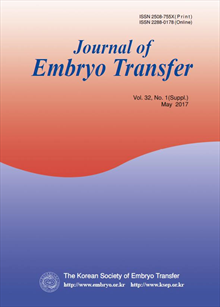간행물
한국동물생명공학회 학술대회논문집

- 발행기관 한국동물생명공학회(구 한국수정란이식학회)
- 자료유형 학술대회
- 간기 반년간
- 수록기간 1997 ~ 2018
- 주제분류 자연과학 > 생물공학 자연과학 분류의 다른 간행물
- 십진분류KDC 527DDC 636
권호리스트/논문검색
2003년도 제3회 발생공학 국제심포지움 및 학술대회 (2003년 10월) 95건
1.
2003.10
구독 인증기관 무료, 개인회원 유료
3,000원
2.
2003.10
구독 인증기관·개인회원 무료
3.
2003.10
구독 인증기관 무료, 개인회원 유료
Pig organ is thought to be the most suitable nonhuman organ for xenotransplanstation. However, one of the major constraints to using pig organs for xenotransplantation is human natural antibody-mediated hyperacute rejection (HAR). Elimination of a(1,3) galactosyltransferase (GGTA1) from the pig is expected to be a solution to the problem of hyperacute rejection. ry1any efforts have made characterization of GGTA1 in structure and function. improvement in the technique of DNA transfection of somatic cells and advancement of the pig NT, a specific modification has been made to one copy of the GGTA1 gene by Missouri group in 2002. To date because homozygousity of the genetic modification has been achieved in this gene, the role of gala(1,3) gal specific natural antibody in HAR and the efficacy of xenotransplantation in a nonhuman primate model will be addressed. If other genes are found to be involved in rejection of pig donors by primates, the technology will be available to modify those genes so that rejection can be overcome.
4,200원
4.
2003.10
구독 인증기관·개인회원 무료
5.
2003.10
구독 인증기관·개인회원 무료
6.
2003.10
구독 인증기관·개인회원 무료
7.
2003.10
구독 인증기관 무료, 개인회원 유료
3,000원
8.
2003.10
구독 인증기관 무료, 개인회원 유료
It is remarkable that nuclear transfer using differentiated donor cells can produce physiologically normal cloned animals, but the process is inefficient and highly prone to epigenetic errors. Aberrant patterns of gene expression in clones contribute to the cumulative losses and abnormal phenotypes observed throughout development. Any long lasting effects from cloning, as revealed in some mouse studies, need to be comprehensively evaluated in cloned livestock. These issues raise animal welfare concerns that currently limit the acceptability and applicability of the technology. It is expected that improved reprogramming of the donor genome will increase cloning efficiencies realising a wide range of new agricultural and medical opportunities. Efficient cloning potentially enables rapid dissemination of elite genotypes from nucleus herds to commercial producers. Initial commercialisation will, however, focus on producing small numbers of high value animals for natural breeding especially clones of progeny-tested sires. The continual advances in animal genomics towards the identification of genes that influence livestock production traits and human health increase the ability to genetically modify animals to enhance agricultural efficiency and produce superior quality food and biomedical products for niche markets. The potential opportunities inanimal agriculture are more challenging than those in biomedicine as they require greater biological efficiency at reduced cost to be economically viable and because of the more difficult consumer acceptance issues. Nevertheless, cloning and transgenesis are being used together to increase the genetic merit of livestock; however, the integration of this technology into farming systems remains some distance in the future.
5,500원
9.
2003.10
구독 인증기관 무료, 개인회원 유료
4,000원
10.
2003.10
구독 인증기관·개인회원 무료
11.
2003.10
구독 인증기관·개인회원 무료
Sung, Ji-Hye, Lim, Chun-Kyu, Cho, Jae-Won, Choi, Hye-Won, Koong, Mi-Kyoung, Yoon, Hyun-Soo, Jun, Jin-Hyun
12.
2003.10
구독 인증기관·개인회원 무료
13.
2003.10
구독 인증기관·개인회원 무료
14.
2003.10
구독 인증기관·개인회원 무료
15.
2003.10
구독 인증기관·개인회원 무료
Jeong, Hyung-Bok, Park, Ji-Gweon, Choi, Jin-Young, Jin, Young-Jun, Yang, Myung-Cheon, Hyun, Kyung-Man, Kim, Gi-Ok, Kim, Se-Jae
16.
2003.10
구독 인증기관·개인회원 무료
17.
2003.10
구독 인증기관·개인회원 무료
18.
2003.10
구독 인증기관·개인회원 무료
Ki, Ho-Youn, Lee, Su-Jung, Shin, Jae-Ho, Kang, Il-Hyun, Moon, Hyun-Ju, Kim, Tae-Sung, Bae, Hoon, Dong, Mi-Sook, Yoon, Yong-Dal, Han, Soon-Young
19.
2003.10
구독 인증기관·개인회원 무료

